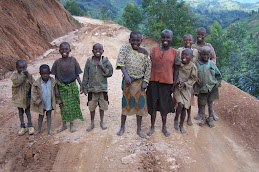The nicest part of Kazimierz is Szeroka Street, a wide road at the centre of the old Jewish quarter. Many Jewish businesses have returned after the holocaust; in particular there are at least three restaurants.

The oldest part of Krakow is the hill, right next to the River Vistula, on which stand both castle and cathedral. Under the castle hill there is a cave - still visible - and the local legend tells of a dragon called Krak who used to be fed a diet of virgins etc in return for protecting the town. A metal statue of Krak belches fire every ten minutes or so. It's quite spectacular at night! We loved the randomness of these domes on side chapels of the cathedral:

About 40 miles away from Krakow is the small town of Oswiecim, better known under its German name of Auschwitz. Auschwitz is a major railway junction with lines accessing all parts of central Europe - hence its choice as the ideal site for a camp.
The actual camp buildings are in two parts. Auschwitz proper is a former Polish army barracks taken over by the Germans after their invasion of Poland. Birkenau, the death camp, is about five minutes away by bus. Even now, the sheer scale and extent of the camp is sobering.
Some things are very deceptive. We visited on a bright, cold spring day, and the brick barracks of Auschwitz didn't feel as sinister as I expected - until you saw the lines of electrified wire. The dense crowds of visitors, including some from Germany and huge numbers from Britain, seemed somehow to populate the camp and made it less sinister than if we had been the only people there.
Inside the barracks the exhibits spoke for themselves and reduced us to silence. Huge display cases full of children's clothes, of shoes, spectacles, wooden limbs. Recreations of the cramped sleeping bunks, tiered three high.
In one corner, adjacent to each other, were the "hospital block" where Mengele and others carried out experiments, the execution wall, and the punishment block. Throughout the barracks were photos of inmates showing their dates of entry and death. The average life expectancy seemed to be around 4-5 months.

Here is the main gate with its infamous "Arbeit Macht Frei" slogan:

And this is a small corner of the extermination camp at Birkenau. The sheer scale of this place is staggering. Four huge gas chambers and crematoria were sited in the woods at the rear of the photo. The majority of the huts were wooden and have been demolished or rotted away, but each hut had a brick chimney stack and these have survived. The chimneys stand like humans grimly at attention. It is a profoundly sad place, even on a bright spring morning. We were glad to have visited this awful place, but more than ready to get back on the coach and head back for sanity in Krakow.


















No comments:
Post a Comment